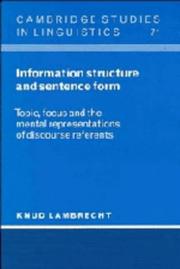| Listing 1 - 1 of 1 |
Sort by
|

ISBN: 0521380561 0521587042 1316039498 0511620608 9780521587044 9780511620607 9780521380560 Year: 1994 Volume: 71 Publisher: Cambridge : Cambridge university press,
Abstract | Keywords | Export | Availability | Bookmark
 Loading...
Loading...Choose an application
- Reference Manager
- EndNote
- RefWorks (Direct export to RefWorks)
Why do speakers of all languages use different grammatical structures under different communicative circumstances to express the same idea? Professor Lambrecht explores the relationship between the structure of the sentence and the linguistic and extra-linguistic context in which it is used. His analysis is based on the observation that the structure of a sentence reflects a speaker's assumption about the hearer's state of knowledge and consciousness at the time of the utterance. This relationship between speaker assumptions and formal sentence structure is governed by rules and conventions of grammar, in a component called 'information structure'. Four independent but interrelated categories are analysed: presupposition and assertion, identifiability and activation, topic, and focus.
801.56 --- Grammar, Comparative and general --- -Discourse analysis --- Pragmatics --- -Comparative grammar --- Grammar --- Grammar, Philosophical --- Grammar, Universal --- Language and languages --- Philosophical grammar --- Linguistics --- Philology --- Pragmalinguistics --- General semantics --- Logic, Symbolic and mathematical --- Semantics (Philosophy) --- Discourse grammar --- Text grammar --- Semantics --- Semiotics --- Syntaxis. Semantiek --- Sentences --- Syntax --- Grammar, Comparative --- Philosophy --- Discourse analysis. --- Pragmatics. --- Sentences. --- Syntax. --- -Syntaxis. Semantiek --- 801.56 Syntaxis. Semantiek --- -Pragmalinguistics --- Comparative grammar --- Discourse analysis --- Sentences (Grammar) --- Phrase (Linguistique) --- Syntaxe --- Analyse du discours --- Pragmatique --- -Discourse analysis. --- -Grammmar, Comparative and general --- Arts and Humanities --- Language & Linguistics --- -801.56 Syntaxis. Semantiek --- Grammar, Comparative and general Syntax --- -Sentences
| Listing 1 - 1 of 1 |
Sort by
|

 Search
Search Feedback
Feedback About UniCat
About UniCat  Help
Help News
News